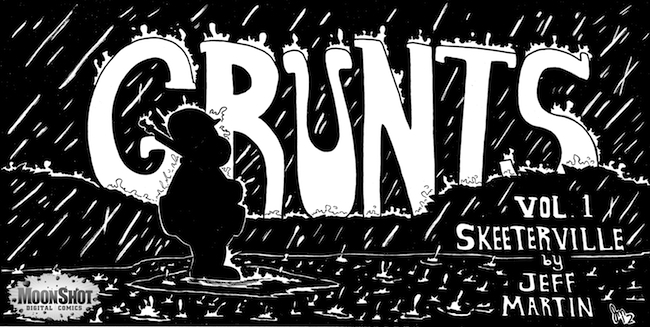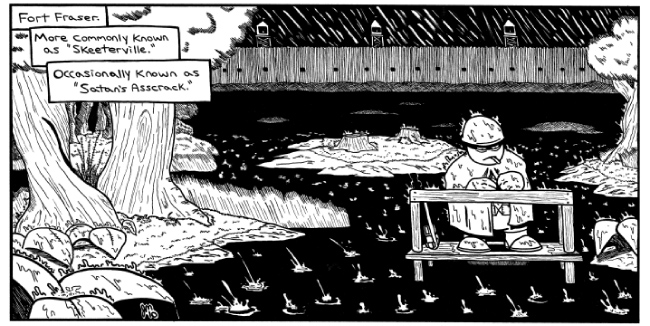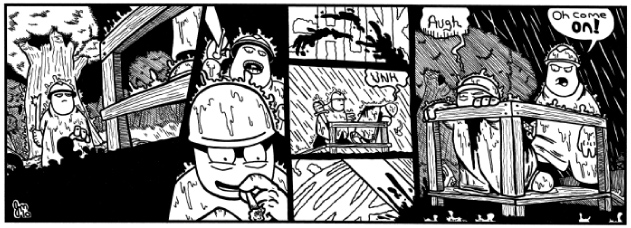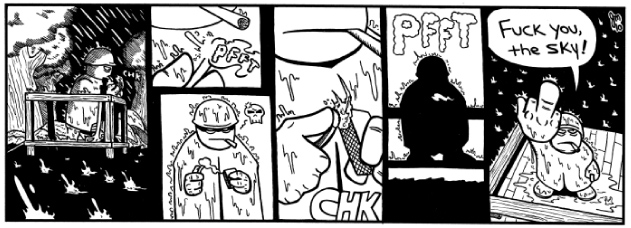“It will probably be available on your toaster in a few years” Cartoonist Jeff Martin talks about his new comic strip Grunts and the growth of digital comics
The latest book to be launched by digital publishers MoonShot Digital is comic strip Grunts by Jeff Martin. Jeff made his name with web comic HEAT, but for this new outing he has combined his love of comics with his history degree from the University of Alberta to create a unique view of a fictitious civil war, based loosely on WWI, from the point of view of those unfortunate enough to be involved. But don’t worry, it’s not all doom and gloom, there’s still some jokes and plenty of explosions along the way! We got in touch with Jeff to ask him where his inspiration for the title came from and just how difficult is it to come up with different ways to have people failing to smoke in the rain!
Tell us a bit about your new comics Grunts and the inspiration behind it? ?
JM: Grunts is a war story set in a fictitious civil war between the West and East. I don’t go into the history of the war much in the four issues that are currently in production, but one of the core elements I wanted to include in the conflict was a lack of a clear villain. In a World War II comic, there’s a really obvious bad guy in the Nazis. Even in the American Civil War – which in North America is referred to as “the” civil war, because most of our media here in Canada is American) – the guys who want to keep slavery are pretty easy to cast as villainous. I liked the idea of the opposing force being considered an “other” while actually being pretty much the same as the protagonists. I guess it’s kind of a culture-level extrapolation of the idea that the qualities that you dislike most in others are often qualities that you yourself possess.
Grunts is also heavily inspired by the First World War, especially the visuals. Despite the war in the comic being fictitious, and elements of the world being completely absurd, I did a lot of research in preparation. In fact, Grunts was originally going to be a story about the Canadian Corps in the First World War, but I got bogged down mentally in trying to get every little detail right, which really hampered storytelling. In the end, I changed gears and applied the research I did for that story to a fictitious world that I could manipulate however I wanted to.
In terms of aesthetics, I really love the apocalyptic vibe of old World War I photos. Despite the increased devastation of the Second World War, photos from it always look like a war, whereas Great War photos look like the end of the world. Have you ever seen a horse wearing a gas mask? It looks like an alien invader. As a result of this aesthetic, I’ve spent A LOT of time drawing dirt. A lot.
Tell us a bit about how you work, is it pen and ink or do you work digitally? Any preferences on which is best?
JM:I start by printing the script for the entire volume. Each strip starts as a template printed onto heavier than usual 8.5” x 11” printer paper. Once I’ve got my template ready, I read over the next few pages (in case I need to include something in the background to set something up for later) and then start thumbnailing the current strip. My thumbnails are probably a lot closer to literal, size-wise than most artists, but I’m more comfortable working at small sizes. Which works out nicely, since I do all of the thumbnails on the script. The strip gets drawn and inked on paper, then I scan it and send it off to George at MoonShot. The only digital stuff I do is occasionally filling in blacks that I missed in the inking or that just turned out poorly.
The cover for volume 1 is unique in that it’s the most heavily digital piece in the entire series. Which isn’t really saying a lot, as all I did was use the paint tool to remove a bayonet which the MoonShot crew pointed out looked like a dangling poop out of context.
What sort of format will the comic be released in (weekly strips or a monthly anthology) and are you planning on keeping to a traditional comic strip style panel design or branching out into different formats?
JM: At this point I believe the plan is to release the four volumes monthly. In the four volumes that are already completed I stick to the strip format, with the only notable variations being the larger splash pages. They’re the same width as the usual strips, just an inch and a half taller. I used those less as I went along because I tended to get a little overzealous with the details, so they ended up taking forever. There’s one page in the first volume that has 99 separate characters on it. I know that because I counted them. The worst part of drawing that page? The 99 characters weren’t even the important part.
I really enjoy the strip format, so I wouldn’t move away from it with Grunts unless there was a good reason to do so. I think it’s an underutilized format nowadays, especially when you consider that the vast majority of the comics using the strip style use a three or four panel newspaper joke strip format. That’s all well and good, but there’s a lot more that can be done with a horizontal page structure than just “set up-set up-set up-punchline,” and in Grunts I’ve tried to explore some of those possibilities.
What are your thoughts on the growth of digital comics in the last couple of years? Are you an iPad or tablet user yourself and what do you think of them as a medium for reading and even producing comics?
JM: Love it. I don’t have a tablet, so I don’t read many comics digitally other than webcomics, but I think the growth of digital comics can only be positive for the medium as a whole. There are less than 3000 comic shops in North America, and about ten of them are in my home town of Edmonton, Alberta. There are huge swathes of the North American market that don’t have physical shops, and so they have to rely on the internet to either order physical comics from shops or read digitally, so from an accessibility standpoint the development of digital comics could prove to be very powerful.
What I’m most interested in seeing is how the continued development of digital comics influences the types of material that are being produced. The direct market is buried under superhero monthlies. While superheroes are certainly a worthwhile genre and have a lot of cache in popular culture in general, it can be tough to find things to read if your interests lie elsewhere. I’m lucky enough to have a local shop which heavily stocks non-superhero books, so on any given day I can go down to the store and pick out a western, a war comic, a noir thriller, or any number of other titles that don’t centre around superpowered people in capes. What really interests me about digital comics is how the representation of genres could shift. Print publishers tend to be reluctant to touch westerns, for example, but with less overhead and start-up costs, maybe they’ll get big in the digital comics scene. The same could be said for any number of other genres. Stuff like that is really intriguing to me, and something I’ll be keeping an eye on.
You’ve had plenty of experience of releasing you web comic ‘Heat’ online, but how would you like to see Grunts develop, perhaps on new platforms like the iPad? Any plans to develop any of your other titles going forward or is it all about Grunts at the moment?
JM: Grunts will definitely be released on the iPad, as well as other tablet devices, cell phones, computers, and anything else that runs apps. So, at the current rate of technology, Grunts will probably be available on your toaster in a few years.
Releasing HEAT online, as well as a few previous projects, has been a great experience for me. I think nowadays the web is the best place for artists to cut their teeth, because it forces you to draw. There’s a group of artists in Edmonton (opendoorcomics.com) that meet frequently to talk shop, and one of the major stumbling blocks for a lot of people is simply getting pages done and moving on to the next. Working on webcomics really taught me that at a certain point you just have to call a page done and move on. Maybe there are things about it you don’t like, or even hate. Maybe you’re horrified at the thought of posting it. But do it anyway! Learn from it, and apply that to the next page. The first HEAT pages are awful when you compare them to the stuff I’m doing now, but posting them, getting feedback, and just knowing that there was an audience out there who was enjoying what I was creating was a great motivating factor to keep working hard and improving.
I guess that kind of also answers your question about whether it’s all Grunts. I self-published a HEAT trade paperback in 2011 and am nearing completion of the second trade collection, which I’m hoping to have ready for release in the spring/summer of 2013. I have no plans on stopping work on HEAT anytime soon, as it’s a ton of fun, but I also have a lot of other ideas that I want to try to do something with. I don’t have anything else in the works with MoonShot or any other publishers, but I have a couple of projects in particular that I’d really like to get off the ground. And hey, if Grunts does well, I’m not opposed to drawing more squat, dumpy men committing ultraviolence on each other.
How have the guys at MoonShot helped you out and how did you get in touch with them or did they get in touch with you?
JM: I heard about MoonShot through Twitter, I think via the folks at Comic Academy. Grunts started as a side project while I was working on HEAT, just to give me something different to draw after doing a handful of HEAT pages. A bit of a palette cleanser, in a way. After a while I found myself with a finished 30 page story and no real idea what to do with it, so I decided to start pitching it and see what happened. I got lucky and George Lentino at MoonShot liked my pitch, and after a Skype interview, production started.
MoonShot has provided some editorial help, but the biggest thing for me is that they take care of the parts of making comics that I suck at because I’d rather be drawing. Handling the details of getting the pages from the files I send them to the final product that people will see, marketing, setting up interviews like this one, all that kind of stuff.
Finally, your web comic ‘HEAT‘ is all about wrestling, why do you think there seems to be such a strong link between comics and wrestling? We’ve interviewed Jill Thompson here on the site earlier in the year who seems to be working with a lot of WWE superstars, so what’s the connection?.
JM: I think the stock answer for this one is that wrestling shares a lot of similarities with superhero comics: colourful costumes, the battle of good versus evil, facepunching as a universal solution to problems.
The thing for me is that wrestling is already a storytelling medium, so the translation to comics isn’t that big of a jump. You can create all sorts of conflict while having a built-in means of settling those conflicts (matches) which can, in the process, create new conflicts. It’s great! HEAT might be the hardest time I’ve had writing because each section I write gives me a bunch of ideas for ways the story could branch off or how an event could play into future stories. It makes it tough to choose what to go with, and I’ve ended up cutting a lot of stuff that would probably be pretty interesting. I could probably come up with a few more years of material without the characters ever leaving the Prison Asteroid, but then I’d risk getting into Walking Dead territory with “they’ve been in the goddamn prison foreeeeeeever.”
Speaking of Jill Thompson, I credit her with a lot of the improvement in the quality of the art in HEAT, and my art in general. I met her at the Calgary Comic & Entertainment Expo in 2010 and she was gracious enough to look over my portfolio, then spent about a half hour critiquing my work and giving me some wonderful advice on where things needed improving and, most importantly, HOW to make those improvements. There’s a jump in the quality of HEAT strips somewhere around page 50 (I don’t know if normal people notice it, but I do), which incidentally were the pages I was drawing shortly after meeting Jill. She’ll likely be getting a special thanks mention in the second TPB collection.
Finally, there seems to be a running thread in Grunts about characters not being able to smoke, what’s the story behind that?
JM:The running joke about soldiers trying to smoke and failing started as a one-off bit in the opening scene of Grunts Volume 1. I never intended for it to go past the one strip, as it began with me being entertained by the idea that somebody would try to smoke during a rain storm then angrily blame the sky like it was out to screw with him specifically. That expanded into three or four pages and became something of an early plot point, and became a running bit at the suggestion of a friend who I was telling about the joke. I liked the idea of nobody being able to smoke successfully, especially after researching the First World War quite heavily and learning that smoking was pretty much omnipresent amongst the soldiery, since pretty much anything that took their mind off of the constant looming doom of their existence was quite welcomed. Keeping it up was pretty easy, since the entire first volume takes place during a rain storm and, as it turns out, matches don’t fair well in such an environment. Volume 1 was as far as the runner went, though. I can’t remember why, to be honest, but it definitely didn’t stick around through volume 2, the first half of which has somebody or other smoking almost constantly. In retrospect I kind of wish I had kept that joke going throughout all four volumes while ratcheting up the absurdity.
For more information on Jeff’s work visit his website at or follow him on twitter @heatcomic. You can also find out more via the MoonShot Digital Comics website.






